We were sailing past the rings of Saturn, the disc of rocks, ice, and moonlets that circle our second-largest neighbor—so naturally my whole body was rattling. It was only after the lights came up that I noticed the actual reason: metal boxes beneath each seat, designed to vibrate our butts in sync with the universe.
I was at Worlds Beyond Earth, the new show at the Hayden Planetarium’s Giant Sphere theater at New York’s American Museum of Natural History. And the simulated sensation of spaceflight goes way beyond seat shakers. The museum now boasts what its president, Ellen J Futter, said last year is not only the most advanced planetarium on the planet but “the most advanced planetarium ever attempted.”
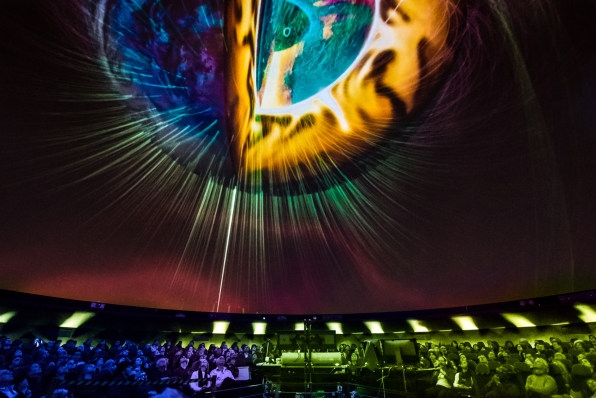
[Photo: AMNH]
Since 1935, the planetarium near Central Park has been a special sort of cosmic cathedral. When it reopened in 2000 as a giant illuminated orb, designed by Polshek Partnership, it appeared to float within a six-story glass case. The planetarium also upgraded its famous Zeiss star projector, which has dazzled generations of starry-eyed kids with its detailed, glimmering replica of the night sky and its tilting-and-whirling mechanism. The current model is the world’s first Zeiss Mark IX.
The legendary Zeiss, however, is being eclipsed. Since the turn of the century, the Hayden, like many planetariums, has increasingly also relied on so-called “fulldome” projectors that can cover the entire inside of the dome, immersing the audience in sophisticated imagery. Rather than just letting viewers gaze at the night sky, it lets the planetarium fly audiences to any time and place within it. The current system, built by a company called Christie Digital and installed over the summer, is made up of six custom synchronized projectors that bathe the dome in 8K-resolution laser light at 60 frames per second, with the widest available color range and contrast. (The dome also features 23 speakers and two subwoofers, along with those seat shakers.)
Those features mean that the system’s ability to reproduce the universe’s most vivid colors is unrivaled, says Carter Emmart, the museum’s astro-visualization director. And then there are its blacks: blacker than any blacks he’s seen in a fulldome show, the black of space. That kind of blackness, he says, “this is the holy grail.”

[Photo: D. Finnin/© AMNH]
But the projectors aren’t even the biggest stars of the show. Worlds Beyond Earth is the first new film at the Hayden in six years. The last one, Dark Universe—narrated by Hayden director and Pluto-demoter Neil de Grasse Tyson—was about the phenomena that help to explain the formation of the universe. “Worlds,” written by geologist Natalie Starkey, is more literal and local: in half an hour, we learn how our solar system came to be, what makes for such unwelcoming conditions on other planets, and in turn what makes Earth so habitable. The larger subtle point is underlined near the end by the narrator, the actress Lupita Nyong’o: the Earth’s climate is just right for nurturing life, which means it’s also easy to mess up.
Look at our next-door neighbor Venus. “We could almost call it Earth’s twin,” says Nyong’o as we swoop below its thick clouds. Thanks to the Magellan spacecraft, we know that Venus is covered with volcanoes that can feed the atmosphere with water vapor and other gases. Except Venus has no magnetic field, which left it exposed to harsh solar winds that stole its water, allowing carbon dioxide to build up in its atmosphere. That resulted in a global greenhouse effect so intense that the planet’s surface is hot enough to melt lead. Understanding how that happened has taught us about the runaway effects that come with adding more carbon dioxide to our own atmosphere. (The film doesn’t mention it, but our own CO2 levels are now the highest they’ve been in 14 million years.)
“I think it’s really interesting that we did not set out to make a show about Earth,” says Vivian Trakinski, the Hayden’s director of science visualization, who produced the film. The idea was to focus on the surprising attributes of other planets, “but as we developed the script, that inevitably led us to the conclusion that it really was about our own understanding and appreciation of the Earth.”
The show’s curator, Denton Ebel, a geologist who runs the museum’s department of Earth and planetary sciences, said he wanted to showcase the worldly phenomena that tie our planets together but also set them apart. “We have all these processes that are similar—we have magnetic fields, we have volcanoes, we have atmospheres, we have gravity,” he says. “And yet these processes lead to this huge diversity of outcomes.”
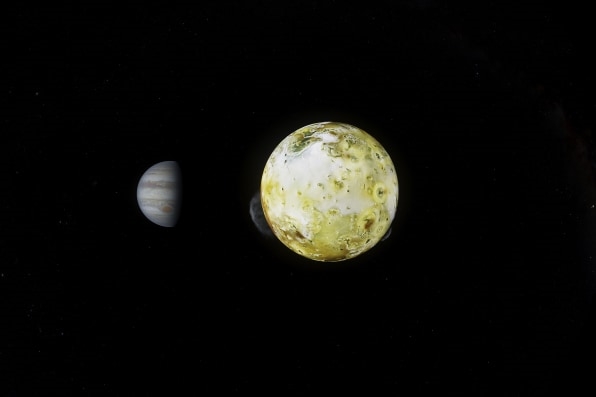
[Photo: © AMNH]
The film begins at the birth of the solar system, before taking us on a time-traveling tour of our moon, Saturn and its moon Titan, Jupiter and Io, Venus, and Mars. There’s a ride-along with a comet, which is like a small world onto itself, carrying not only dust and ice but also amino acids, the basic ingredients for life. Astronomers have found that comets may have ferried vital chemicals like phosphorus to Earth, giving rise to life here four billion years ago.
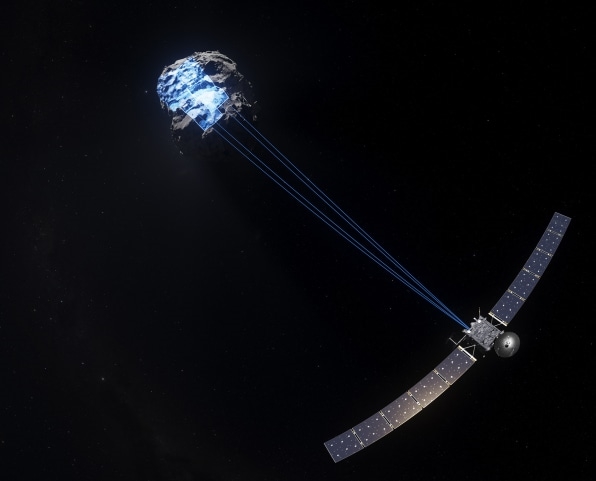
[Photo: © AMNH]
One reason we know this about comets is that, rather than just study them through telescopes, now we can actually land on them. The profusion of new data from an array of spacecraft and robots means that untangling the solar system’s mysteries increasingly involves not only astronomers but geologists like Ebel (he’s the first one to curate a Hayden show). These up-close-and-personal encounters with the solar system are also what make many of the sequences in Worlds Beyond Earth so realistic. For much of the film, these aren’t garden-variety simulations we’re looking at, but elaborate data visualizations.
Reconstructing the solar system
The ability to give Hayden audiences such a precise view of space is something new. “We actually use the term—which is interesting—we say reconstruction, based on all the imagery,” Emmart told me. “In the case of images from Saturn with Cassini, we can reconstruct exactly the view” from the spacecraft.
The idea was not just to show the world we know but give a sense of how we know it.”
Vivian Trakinski, Producer of Worlds Beyond Earth
A century ago, astronomers relied solely on telescopes and illustrations to depict these places. Using OpenSpace, an open-source software platform that the Hayden planetarium developed with NASA, the filmmakers could convert raw mission data into detailed 3D visualizations, building intricate photo-mosaic fly-throughs even in real time. It’s basically a very advanced version of Google Earth, but for the universe. (The Hayden offers the software, along with its Digital Universe data set, for free download.) To reconstruct the solar system we see in the film, the filmmakers relied on data from seven missions and computer simulations conducted by NASA, Europe, and Japan, starting with Apollo 15 in 1971 and including missions that are on Mars right now.
“The idea was not just to show the world we know but give a sense of how we know it,” Trakinski said. “It’s not animation. It’s really an exploration of the science itself.”
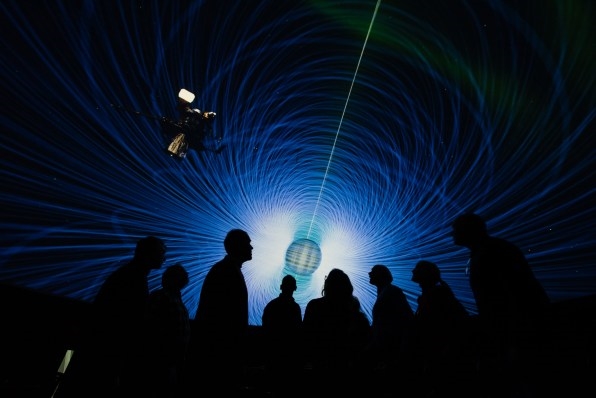
[Photo: D. Finnin/© AMNH]
There are still simulated sections and cinematic flourishes, like stunning visualizations of Earth’s and Jupiter’s magnetic fields, and a body-shaking moon landing, with the Apollo 15 lunar module. For the latter sequence, the Hayden tapped a few experts: John Knoll, the chief creative officer of Industrial Light and Magic, cocreator of Adobe Photoshop, and amateur Apollo historian; and Dave Scott and Charlie Duke, who piloted the Apollo 15 and Apollo 16 lunar modules respectively.
To replicate the scene’s sounds and visuals, Emmart asked the astronauts what they recalled as they deftly guided their crafts to the moon’s dusty surface. “[Scott] said, ‘I was trying to land this thing, so I had to be totally in the zone!’” But both reported feeling the kick of the engine and the thrusters, says Emmart.
“[Duke] didn’t say it kicked like a mule, but he definitely felt it. So I said, let’s put that into the seat players!”
From the stars to Pink Floyd to the blackest black
Modern science revolves around continuously updated models of the universe, and planetariums have followed suit. In 1923, just as Einstein’s theory of relativity was making waves, the prototype for the first modern planetarium, known as the Star Theater, opened on the roof of the Zeiss Works in Jena, Germany, with a pioneering multi-lens projector situated in the center of a new type of domed building. About a decade later, banker Charles Hayden—inspired by Chicago’s groundbreaking Adler Planetarium—pledged to build an even bigger planetarium for New York City, donating $150,000 in the depths of the Great Depression. The goal, he explained, was to give the public “a more lively and sincere appreciation of the magnitude of the universe . . . and for the wonderful things which are daily occurring in the universe.” When it opened in October 1935, lines stretched down the block.
Emmart remembers being stunned by the Hayden’s first laser projector system, the Lazarium, in 1974. With its simple but spectacular vector drawings set to music, the system was a sensation, and helped launch another planetarium tradition: laser Pink Floyd shows. The Hayden stopped doing those in 1997; fulldome projection made its debut the following year.
Laser light, which can offer a brighter, sharper image than LCD or LED and other technologies, led the Hayden and other planetariums to upgrade their systems again in the early 2000s. Six years ago, museum officials began discussions with Christie, a leading digital projector maker, about a more radical upgrade to the Giant Sphere. The result, the Eclipse, is built around six digital micromirror devices, or DMDs, allowing for the widest display of colors possible in any projector. Christie says it can encompass nearly all of what cinema nerds call the Rec. 2020 color gamut, a spectrum of hues that are easy for, say, a vivid supernova to generate, but heretofore impossible to re-create.
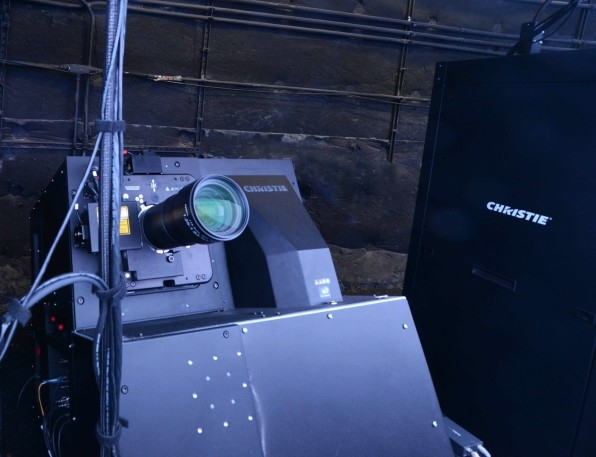
[Photo: C. Chesek/© AMNH]
This range also makes for remarkable contrast levels, the difference between the brightest and darkest image: the new system boosts the planetarium’s existing contrast ratio from 7,000-to-1 to 1,000,000-to-1. (Most movie theater projectors have a ratio of only 2,000 to 1.) That solves a central problem of laser projectors: displaying bright objects like suns or quasars can disrupt the darkness of the night sky in other parts of the image. That means the Hayden comes closer than anything else on Earth to mimicking not only the vibrant colors of the universe but the actual darkness of the night sky. For anyone used to New York’s bleached night skies, this is quite black.
“It brings out the black of space and allows us to visualize these things as they’re really there,” Emmart said.
(The quest to emulate the night sky has also led to the world’s blackest paint. The pigment known as Vantablack was designed by NASA scientists with a coating of carbon nanotubes, and meant to be applied to satellites so they won’t reflect light and thus disrupt ground-based astronomy. When the artist Anish Kapoor exclusively licensed the pigment in 2016, he sparked an art-world battle over the blackest black.)
Where we go from here
The hyperrealism of the Hayden’s simulacra—space black, 8K resolution, shaking seats, the renderings, the data itself—may invite ruminations about just how real simulations can get, about where models end and “reality” begins, and about how to teach science.
What we can show you of the universe can take you back.”
Carter Emmart, Hayden Planetarium
And yet, the Hayden is only a sign of what’s to come. In the quest for blacker blacks, richer colors, and more realistic graphics, the sky’s the limit. Emmart thinks the planetariums of the future are likely to trade their projectors for advanced LED screens that can cover the entire interior of a dome. These systems are currently finicky and challenging to scale, but he hears they’re already being built in China. “Even with the latest technology, to some degree, [the Hayden’s system] is the Model A of what’s going to be around in 10, 20 years,” he says.
As we sailed around Saturn, I got a glimpse of that future, when planetariums won’t just show us models of the solar system but send us out into ever realistic models of it. This idea excites Emmart. The planetarium could democratize what he says will be the “elite sport” of civilian space travel as envisioned by companies like Virgin Galactic and SpaceX.
“My joke is, “Honey, sell the house, I’ve got to go to space for 15 minutes,’” he says. “There are lots of people for whom the price of a house is nothing, I guess, so they’re the ones that are going to go.” For the rest of us, experiences such as the Hayden’s new show will be the next best thing, and they’ll keep getting better.
“What we’re doing is honing this ability to provide authentic travel through the known universe,” adds Emmart. “Call it data, call it knowledge, call it what you will, based on imagery and sensors and all of this. But this all comes together as an authentic experience.”
Under the dome, he can immerse people in things and places long gone, stuff no one ever saw, billions of years old. It’s like the museum’s famous ancient dioramas.
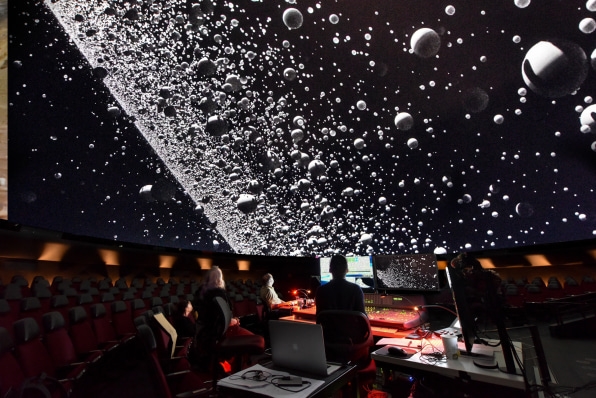
[Photo: D. Finnin/© AMNH]
“I revere our dioramas because they are a suspension in another place,” says Emmart. “You come to this museum and you’re suddenly standing on the Plains in Wyoming looking at buffalo, and you’re not only standing looking at buffalo, because the buffalo and these millions of herds, they’re no longer there—you’re seeing something from the past. Maybe it doesn’t hit you quite as much as dinosaur bones, but you’re seeing something that just doesn’t exist anymore. So even the dioramas are like a time machine. And in large measure, what we can show you of the universe can take you back.”
Getting to go back is an eye-opening treat. Near the start of the new show, we sail toward a simulation of our young sun, some 4.5 billion years ago, as the solar system was just starting to take shape. Our neighborhood likely began as what’s known as an accretion disc, a cloud of matter swirling around the sun much in the way those rocky rings circle Saturn today. Within this disc of debris, materials glommed together like chunks of chocolate in a violent mix of cookie dough, eventually gathering themselves into their own orbits, and then into the giant orbs we call Mercury, Venus, Earth, Mars, Jupiter, Saturn, and Neptune, along with the rest of the mysterious stuff floating around the solar system. Over time, all kinds of accidents happened. You realize how Earth could have turned out like these other places, but didn’t, at least not yet. Which is good, because, among other things, now we can go to the planetarium.
This story has been updated to clarify that while fulldome projection debuted in 1998, laser fulldome projectors arrived the following decade; and to correct the attribution of a quote by Apollo astronaut Dave Scott, which had previously been attributed to his colleague Charlie Duke. We regret the errors.
(74)